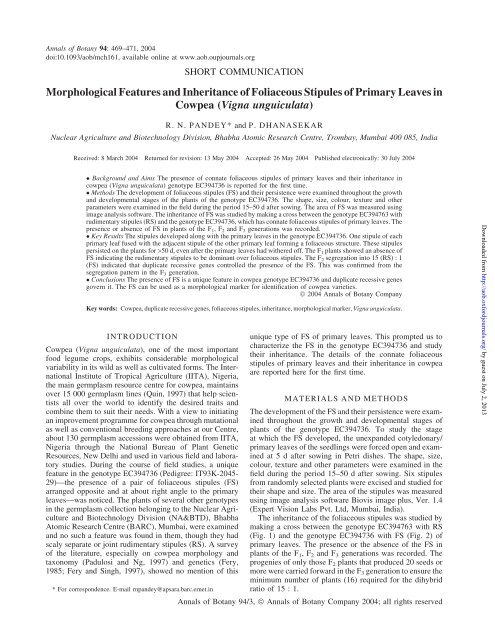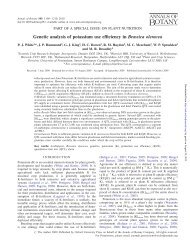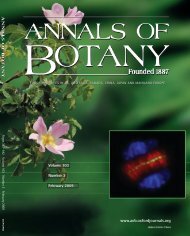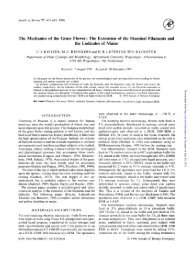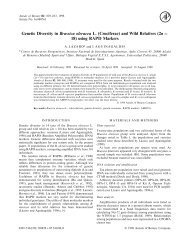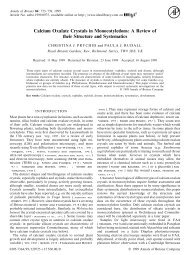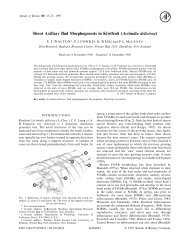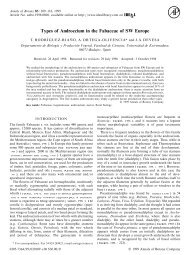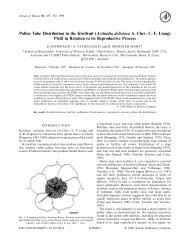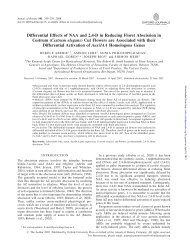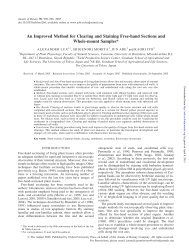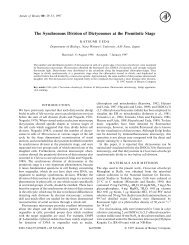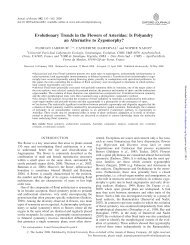Morphological Features and Inheritance of Foliaceous Stipules of ...
Morphological Features and Inheritance of Foliaceous Stipules of ...
Morphological Features and Inheritance of Foliaceous Stipules of ...
You also want an ePaper? Increase the reach of your titles
YUMPU automatically turns print PDFs into web optimized ePapers that Google loves.
Annals <strong>of</strong> Botany 94: 469–471, 2004<br />
doi:10.1093/aob/mch161, available online at www.aob.oupjournals.org<br />
SHORT COMMUNICATION<br />
<strong>Morphological</strong> <strong>Features</strong> <strong>and</strong> <strong>Inheritance</strong> <strong>of</strong> <strong>Foliaceous</strong> <strong>Stipules</strong> <strong>of</strong> Primary Leaves in<br />
Cowpea (Vigna unguiculata)<br />
R. N. PANDEY* <strong>and</strong> P. DHANASEKAR<br />
Nuclear Agriculture <strong>and</strong> Biotechnology Division, Bhabha Atomic Research Centre, Trombay, Mumbai 400 085, India<br />
Received: 8 March 2004 Returned for revision: 13 May 2004 Accepted: 26 May 2004 Published electronically: 30 July 2004<br />
Background <strong>and</strong> Aims The presence <strong>of</strong> connate foliaceous stipules <strong>of</strong> primary leaves <strong>and</strong> their inheritance in<br />
cowpea (Vigna unguiculata) genotype EC394736 is reported for the first time.<br />
Methods The development <strong>of</strong> foliaceous stipules (FS) <strong>and</strong> their persistence were examined throughout the growth<br />
<strong>and</strong> developmental stages <strong>of</strong> the plants <strong>of</strong> the genotype EC394736. The shape, size, colour, texture <strong>and</strong> other<br />
parameters were examined in the field during the period 15–50 d after sowing. The area <strong>of</strong> FS was measured using<br />
image analysis s<strong>of</strong>tware. The inheritance <strong>of</strong> FS was studied by making a cross between the genotype EC394763 with<br />
rudimentary stipules (RS) <strong>and</strong> the genotype EC394736, which has connate foliaceous stipules <strong>of</strong> primary leaves. The<br />
presence or absence <strong>of</strong> FS in plants <strong>of</strong> the F 1,F 2 <strong>and</strong> F 3 generations was recorded.<br />
Key Results The stipules developed along with the primary leaves in the genotype EC394736. One stipule <strong>of</strong> each<br />
primary leaf fused with the adjacent stipule <strong>of</strong> the other primary leaf forming a foliaceous structure. These stipules<br />
persisted on the plants for >50 d, even after the primary leaves had withered <strong>of</strong>f. The F 1 plants showed an absence <strong>of</strong><br />
FS indicating the rudimentary stipules to be dominant over foliaceous stipules. The F 2 segregation into 15 (RS) : 1<br />
(FS) indicated that duplicate recessive genes controlled the presence <strong>of</strong> the FS. This was confirmed from the<br />
segregation pattern in the F 3 generation.<br />
Conclusions The presence <strong>of</strong> FS is a unique feature in cowpea genotype EC394736 <strong>and</strong> duplicate recessive genes<br />
govern it. The FS can be used as a morphological marker for identification <strong>of</strong> cowpea varieties.<br />
ª 2004 Annals <strong>of</strong> Botany Company<br />
Key words: Cowpea, duplicate recessive genes, foliaceous stipules, inheritance, morphological marker, Vigna unguiculata.<br />
INTRODUCTION<br />
unique type <strong>of</strong> FS <strong>of</strong> primary leaves. This prompted us to<br />
Cowpea (Vigna unguiculata), one <strong>of</strong> the most important<br />
food legume crops, exhibits considerable morphological<br />
variability in its wild as well as cultivated forms. The International<br />
Institute <strong>of</strong> Tropical Agriculture (IITA), Nigeria,<br />
the main germplasm resource centre for cowpea, maintains<br />
characterize the FS in the genotype EC394736 <strong>and</strong> study<br />
their inheritance. The details <strong>of</strong> the connate foliaceous<br />
stipules <strong>of</strong> primary leaves <strong>and</strong> their inheritance in cowpea<br />
are reported here for the first time.<br />
over 15 000 germplasm lines (Quin, 1997) that help scientists<br />
all over the world to identify the desired traits <strong>and</strong><br />
MATERIALS AND METHODS<br />
combine them to suit their needs. With a view to initiating The development <strong>of</strong> the FS <strong>and</strong> their persistence were exam-<br />
an improvement programme for cowpea through mutational ined throughout the growth <strong>and</strong> developmental stages <strong>of</strong><br />
as well as conventional breeding approaches at our Centre, plants <strong>of</strong> the genotype EC394736. To study the stage<br />
about 130 germplasm accessions were obtained from IITA, at which the FS developed, the unexp<strong>and</strong>ed cotyledonary/<br />
Nigeria through the National Bureau <strong>of</strong> Plant Genetic primary leaves <strong>of</strong> the seedlings were forced open <strong>and</strong> exam-<br />
Resources, New Delhi <strong>and</strong> used in various field <strong>and</strong> laborained at 5 d after sowing in Petri dishes. The shape, size,<br />
tory studies. During the course <strong>of</strong> field studies, a unique colour, texture <strong>and</strong> other parameters were examined in the<br />
feature in the genotype EC394736 (Pedigree: IT93K-2045- field during the period 15–50 d after sowing. Six stipules<br />
29)—the presence <strong>of</strong> a pair <strong>of</strong> foliaceous stipules (FS) from r<strong>and</strong>omly selected plants were excised <strong>and</strong> studied for<br />
arranged opposite <strong>and</strong> at about right angle to the primary their shape <strong>and</strong> size. The area <strong>of</strong> the stipules was measured<br />
leaves—was noticed. The plants <strong>of</strong> several other genotypes using image analysis s<strong>of</strong>tware Biovis image plus, Ver. 1.4<br />
in the germplasm collection belonging to the Nuclear Agri- (Expert Vision Labs Pvt. Ltd, Mumbai, India).<br />
culture <strong>and</strong> Biotechnology Division (NA&BTD), Bhabha The inheritance <strong>of</strong> the foliaceous stipules was studied by<br />
Atomic Research Centre (BARC), Mumbai, were examined making a cross between the genotype EC394763 with RS<br />
<strong>and</strong> no such a feature was found in them, though they had (Fig. 1) <strong>and</strong> the genotype EC394736 with FS (Fig. 2) <strong>of</strong><br />
scaly separate or joint rudimentary stipules (RS). A survey primary leaves. The presence or the absence <strong>of</strong> the FS in<br />
<strong>of</strong> the literature, especially on cowpea morphology <strong>and</strong><br />
taxonomy (Padulosi <strong>and</strong> Ng, 1997) <strong>and</strong> genetics (Fery,<br />
1985; Fery <strong>and</strong> Singh, 1997), showed no mention <strong>of</strong> this<br />
plants <strong>of</strong> the F1,F2 <strong>and</strong> F3 generations was recorded. The<br />
progenies <strong>of</strong> only those F2 plants that produced 20 seeds or<br />
more were carried forward in the F3 generation to ensure the<br />
minimum number <strong>of</strong> plants (16) required for the dihybrid<br />
* For correspondence. E-mail rnp<strong>and</strong>ey@apsara.barc.ernet.in ratio <strong>of</strong> 15 : 1.<br />
Annals <strong>of</strong> Botany 94/3, ª Annals <strong>of</strong> Botany Company 2004; all rights reserved<br />
Downloaded from<br />
http://aob.oxfordjournals.org/ by guest on July 2, 2013
470 P<strong>and</strong>ey <strong>and</strong> Dhanasekar — <strong>Foliaceous</strong> <strong>Stipules</strong> <strong>of</strong> Primary Leaves in Cowpea<br />
F IG. 1. Rudimentary stipules (RS) <strong>of</strong> primary leaves in cowpea genotype<br />
EC394763.<br />
FS<br />
F IG. 2. Connate foliaceous stipules (FS) <strong>of</strong> primary leaves in cowpea<br />
genotype EC394736.<br />
RESULTS<br />
Characteristics <strong>of</strong> the foliaceous stipules<br />
The stipules developed along with the primary leaves in the<br />
genotype EC394736. One stipule <strong>of</strong> each primary leaf fused<br />
with the adjacent stipule <strong>of</strong> the other primary leaf forming a<br />
foliaceous structure. The connate foliaceous stipules were<br />
conspicuous as soon as primary leaves exp<strong>and</strong>ed. These<br />
stipules persisted on the plants for >50 d, even after the<br />
primary leaves had withered or dropped <strong>of</strong>f. The characteristics<br />
<strong>of</strong> the foliaceous stipules present in the genotype<br />
EC394736 are shown in Table 1 <strong>and</strong> Figs 2 <strong>and</strong> 3.<br />
<strong>Inheritance</strong><br />
The three F1 plants <strong>of</strong> the cross EC394763 · EC394736<br />
showed absence <strong>of</strong> the FS indicating the dominance <strong>of</strong> RS<br />
FS<br />
T ABLE 1. Characteristics <strong>of</strong> the connate foliaceous stipules <strong>of</strong><br />
primary leaves in cowpea genotype EC394736<br />
Parameter <strong>Features</strong> in foliaceous stipule<br />
Naissance/organogenesis Along with the development<br />
<strong>of</strong> cotyledonary leaves<br />
Phyllotaxy Opposite<br />
Orientation Horizontal (right angle with<br />
reference to primary leaves)<br />
Petiolate/sessile Sessile<br />
Persistence Persistent<br />
Colour Dark green<br />
Texture Smooth<br />
Venation Reticulate<br />
Shape Ovate to obovate<br />
Apex Obtuse to truncate<br />
Margin Entire<br />
Base Acute<br />
Size (total laminar area) 253 mm 2 (range 114–384 mm 2 )<br />
F IG. 3. Variation in size <strong>and</strong> shape <strong>of</strong> the foliaceous stipules.<br />
over FS. In the F2 population <strong>of</strong> 131 plants, only 12 plants<br />
showed the presence <strong>of</strong> FS, while 119 had RS (Table 2). The<br />
segregation into RS- <strong>and</strong> FS-plants indicated a modified<br />
dihybrid ratio <strong>of</strong> 15 : 1 with a c 2 value <strong>of</strong> 1 88 (P =<br />
0 10–0 20), i.e. duplicate recessive genes controlled the<br />
presence <strong>of</strong> FS.<br />
Of the 131 F2 plants, only 93 plants (seven with FS <strong>and</strong> 86<br />
with RS) were carried forward in the F3 generation as plant<br />
to row progenies. This constituted 50, 31 <strong>and</strong> 12 plants <strong>of</strong><br />
three respective families. The number <strong>of</strong> plants in the F3<br />
progenies ranged from 18 to 33. In the 40 segregating progenies,<br />
eight progenies had 18–20 plants, 27 progenies had<br />
21–29 plants <strong>and</strong> five had 30–33 plants each.<br />
All the plants <strong>of</strong> the seven FS progenies bred true for the<br />
FS-character, while only 46 <strong>of</strong> the 86 RS-plant progenies<br />
Downloaded from<br />
http://aob.oxfordjournals.org/ by guest on July 2, 2013
T ABLE 2. Segregation for foliaceous stipules <strong>of</strong> primary<br />
leaves in the F 2 generation <strong>of</strong> the cross EC394763 · EC394736<br />
Observed segregation<br />
Total no.<br />
c<br />
<strong>of</strong> plants<br />
2<br />
F2 family RS FS (15 : 1) P<br />
1 76 69 7 1.137 0.20–0.30<br />
2 42 38 4 0.768 0.30–0.50<br />
3 13 12 1 0.046 0.80–0.90<br />
Total 131 119 12 1.88 0.10–0.20<br />
T ABLE 3. Segregation for the presence <strong>and</strong> absence <strong>of</strong> the<br />
foliaceous stipules in the F3 plant progenies <strong>of</strong> the cross<br />
EC394763 · EC394736<br />
No. <strong>of</strong><br />
progenies<br />
P<strong>and</strong>ey <strong>and</strong> Dhanasekar — <strong>Foliaceous</strong> <strong>Stipules</strong> <strong>of</strong> Primary Leaves in Cowpea 471<br />
No. <strong>of</strong> plants Ratio<br />
Total RS FS O E c 2<br />
7 144 0 144 Tr. Br.<br />
46 1110 1110 0 Tr. Br.<br />
23 546 515 31 16.6:1 15:1 0.305 0.50–0.70<br />
17 408 315 93 3.39 : 1 3 : 1 1.06 0.30–0.50<br />
O, Observed; E, expected; Tr. Br., true breeding.<br />
FS <strong>and</strong> RS indicate the plants with foliaceous stipules <strong>and</strong> rudimentary<br />
stipules, respectively.<br />
bred true for the RS character (Table 3). Of the remaining<br />
40 progenies, 23 segregated into a ratio <strong>of</strong> 15 RS : 1 FS, <strong>and</strong><br />
17 into 3 RS : 1 FS. The segregation <strong>of</strong> the 86 RS plant<br />
progenies in the F 3 generation fitted in the expected genetic<br />
ratio <strong>of</strong> 7 (true breeding for RS) : 4 (segregating into 15 RS :<br />
1 FS) : 4 (segregating into 3RS : 1 FS) with the c 2 value <strong>of</strong><br />
2 394 (P = 0 30–0 50).<br />
DISCUSSION<br />
The segregation pattern <strong>of</strong> the foliaceous stipules observed<br />
in the F2 <strong>and</strong> F3 generations confirmed the involvement <strong>of</strong><br />
duplicate recessive genes in their development.<br />
It is proposed that the gene symbols for foliaceous<br />
stipules <strong>of</strong> primary leaves be fos1 <strong>and</strong> fos2. The genotype<br />
EC394736 with foliaceous stipules can thus be represented<br />
as fos1fos1fos2fos2. Studies on the inheritance <strong>of</strong> stipules in general, <strong>and</strong><br />
foliaceous stipules <strong>of</strong> primary leaves in particular, are<br />
very few <strong>and</strong> reports are scanty. Small stipule size in<br />
American chestnut has been reported to be incompletely<br />
dominant over large stipule size in Chinese chestnut <strong>and</strong><br />
is controlled by two genes (Hebard, 1994), implying that the<br />
large stipule size is a recessive character. This conforms<br />
with the present authors’ findings that recessive genes<br />
control the large size <strong>of</strong> the foliaceous stipules. In jute<br />
also, the foliaceous stipule character has been reported to<br />
P<br />
be recessive though inherited monogenically (Paria <strong>and</strong><br />
Basak, 1994).<br />
The stipules have been recognized as an important morphological<br />
character for identification <strong>of</strong> species or varieties.<br />
Mouli <strong>and</strong> Kale (1982) reported foliaceous stipules<br />
to be a good identifying marker for the early maturing<br />
groundnut TGE-1. The presence or absence <strong>of</strong> foliar stipules<br />
was used to describe various tribes <strong>of</strong> the family Genisteae<br />
(Josefa et al., 1998). Information on stipule development<br />
is useful to the taxonomists (Stein, 1982).<br />
The foliaceous stipules <strong>of</strong> the primary leaves in the cowpea<br />
genotype EC394736 will be used as a morphological<br />
marker in the breeding programme <strong>of</strong> the NA&BTD,<br />
BARC. The phenotypic behaviour <strong>of</strong> the stipule in the F1<br />
could be very useful in detecting successful crosses involving<br />
the genotype EC394736 as a female parent. As this<br />
genotype is endowed with the presence <strong>of</strong> foliaceous stipules<br />
<strong>of</strong> primary leaves, a cross between this parent <strong>and</strong><br />
those with rudimentary stipules as male can be taken as<br />
successful if the F1 shows the absence <strong>of</strong> foliaceous stipules,<br />
a recessive character. The FS character can also be transferred<br />
to any variety for identification. It could be used<br />
during seed multiplication <strong>of</strong> cowpea varieties to check<br />
for any inadvertent, undesirable out-crossing to other cowpea<br />
genotypes that would reduce the purity <strong>of</strong> the seed.<br />
LITERATURE CITED<br />
Fery RL. 1985. The genetics <strong>of</strong> cowpeas: a review <strong>of</strong> the world literature. In:<br />
Singh SR, Rachie KO, eds. Cowpea research, production <strong>and</strong> utilization.<br />
Chichester, UK: John Wiley <strong>and</strong> Sons, 25–62.<br />
Fery RL, SinghBB. 1997. Cowpea genetics:a review <strong>of</strong> the recent literature.<br />
In: Singh BB, Mohan Raj DR, Dashiell KE, Jackai LEN, eds. Advances<br />
in cowpea research. Ibadan, Nigeria: IITA. Co-publication <strong>of</strong><br />
International Institute <strong>of</strong> Tropical Agriculture (IITA) <strong>and</strong> Japan<br />
International Research Center for Agricultural Sciences (JIRCAS),<br />
13–29.<br />
Hebard FV. 1994. <strong>Inheritance</strong> <strong>of</strong> juvenile leaf <strong>and</strong> stem morphological traits<br />
in crosses <strong>of</strong> Chinese <strong>and</strong> American chestnut. Journal <strong>of</strong> Heredity<br />
85: 440–446.<br />
Josefa L, Antonio DJ, Trinidad R, Ana OO. 1998. Seedling morphology<br />
in Genisteae (Fabaceae) from south-west Spain. Botanical Journal <strong>of</strong><br />
Linnean Society 128: 229–250.<br />
Mouli C, Kale DM. 1982. An early maturing groundnut (Arachis<br />
hypogaea) with foliaceous stipule marker. Current Science 51:<br />
132–134.<br />
Padulosi S, Ng NQ. 1997. Origin, taxonomy, <strong>and</strong> morphology <strong>of</strong> Vigna<br />
unguiculata (L.) Walp. In: Singh BB, Mohan Raj DR, Dashiell KE,<br />
Jackai LEN, eds. Advances in cowpea research. Ibadan, Nigeria: IITA.<br />
Co-publication <strong>of</strong> International Institute <strong>of</strong> Tropical Agriculture<br />
(IITA) <strong>and</strong> Japan International Research Center for Agricultural<br />
Sciences (JIRCAS), 1–12.<br />
Paria P, Basak SL. 1994. <strong>Inheritance</strong> <strong>of</strong> some induced mutant characters in<br />
jute (Chorchorus olitorius L.). Indian Journal <strong>of</strong> Genetics <strong>and</strong> Plant<br />
Breeding 54: 347–350.<br />
Quin FM. 1997. Introduction. In: Singh BB, Mohan Raj DR, Dashiell KE,<br />
Jackai LEN, eds. Advances in cowpea research. IITA, Ibadan, Nigeria:<br />
Copublication <strong>of</strong> International Institute <strong>of</strong> Tropical Agriculture (IITA)<br />
<strong>and</strong> Japan International Research Center for Agricultural Sciences<br />
(JIRCAS), ix–xv.<br />
Stein OL. 1982. Stipule arrangement in the genus Caesalpinia (Leguminosae).<br />
Botanical Journal <strong>of</strong> Linnean Society 84: 289–294.<br />
Downloaded from<br />
http://aob.oxfordjournals.org/ by guest on July 2, 2013


